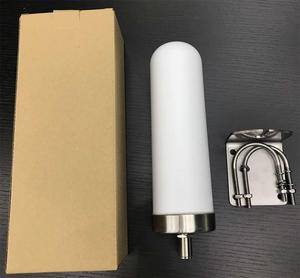(17269 products available)






































































































































































































































An external antenna WiFi router can reach remote areas and make strong connections. It has antennas outside the router that can be moved or reflexive. Some routers have more than one band and support MU-MIMO technology, letting many devices use the same WiFi network without slowing it down.
Here are some known kinds of WiFi routers with external antennas:
Wireless Standards and Speed:
External antenna WiFi routers have different wireless standards. These include Wireless-N, Wireless-AC, and Wireless-AX. Selecting one that fits a business's needs is essential. The Wireless-AC and Wireless-AX models offer faster speeds than Wireless-N. This is useful for companies that need a quicker WiFi connection. A WiFi router with an external antenna can provide different speeds. These range from 300 Mbps to 1300 Mbps or more. The actual speed depends on the wireless standard and antenna configuration.
Range and Antennas:
A WiFi router with an external antenna can reach a wider range than those without. The extent it can reach depends on the external antenna. It often comes in two or more antenna configurations. Each antenna offers different range capabilities. One with a longer range can connect to devices at distances more than 650 feet (200 meters). Businesses that need a good WiFi connection across a large office space or building will find it useful.
Connectivity Options:
Most external antenna WiFi routers have a WAN port. This allows users to connect it to a broadband source like a modem. They also have LAN ports for wired connections to other network devices. Some routers offer tethered connectivity through USB ports. This allows sharing of internet connection and transferring files between devices.
Management and Security Features:
Businesses can manage the external antenna WiFi router with ease. Features on it include security functions that protect sensitive data. It has a web-based interface that allows for changes made from any computer with network access. Users can set up accounts, monitor activities, and change passwords remotely. businesses receive protection against unauthorized access.
Power Supply:
A power adapter usually powers an external antenna WiFi router. Some models allow the router to run through Power over Ethernet (PoE). It includes a PoE injector or switch that sends power and data through an Ethernet cable. Businesses that need to install the router in locations without a power outlet will find this useful. It reduces the amount of cabling needed to set up a network.
External antennas for Wi-Fi routers are used in various industries. In the enterprise, they boost signal distribution to staff and guests in institutions like hospitals, schools, and offices with large or complicated layouts. They use it to reach distant or dead locations. It helps to maintain a steady connection for activities like online learning and telecommuting.
Warehouse and retail use it to improve inventory management and mobile checkout tasks. Ultimately enhancing operational effectiveness. Manufacturers need it for machine connectivity and automated manufacturing tasks. It is for industrial applications where a strong, dependable Wi-Fi signal is needed while working in the outdoor environment.
Oil and gas exploration, mining, field services, and construction all work in remote or difficult locations. They use a laptop or desktop computer to access information in real time. External antennas for Wi-Fi routers help to establish dependable connections for industrial tasks. This is true even in the challenging circumstances of the field.
Marine industries like shipping and logistics, fishing, and harbor operations use it. They establish wireless connections between ships and marine platforms. Antennas withstand harsh weather conditions because they are made for use in open waters. When they are at sea, they stay connected to transmit information.
Event organizers use it to ensure that guests have access to dependable internet service at conferences, concerts, sporting events, and other outdoor gatherings. They may utilize it to support live broadcasting and online sharing. External antennas for Wi-Fi routers help create a good user connection and nice-selling environment.
When choosing an external antenna WiFi router, it is essential to consider various crucial factors to meet specific connectivity needs effectively.
Q: What is the purpose of external antennas on WiFi routers?
A: External antennas on WiFi routers improve the strength and range of signals by providing better coverage and increasing the overall performance of the router.
Q: Can I attach an external antenna to my current WiFi router?
A: It depends on the router. Not all WiFi routers are compatible with external antennas. Users should check their router's documentation or consult the manufacturer to determine compatibility.
Q: How do I know if my WiFi router is compatible with an external antenna?
A: Not all WiFi routers are compatible with external antennas. To find out if a specific router is compatible, manufacturers’ documentation can be referenced.
Q: How do I install an external antenna on a WiFi router?
A: Installation procedures may vary depending on the router and antenna type. Generally, users should connect the antenna to a compatible port on the router, which may be an RP-SMA or SMA connector.
Q: Can I use multiple external antennas on a WiFi router?
A: It depends on the router. Not all WiFi routers support multiple external antennas, but those that do help improve signal coverage and increase overall performance.